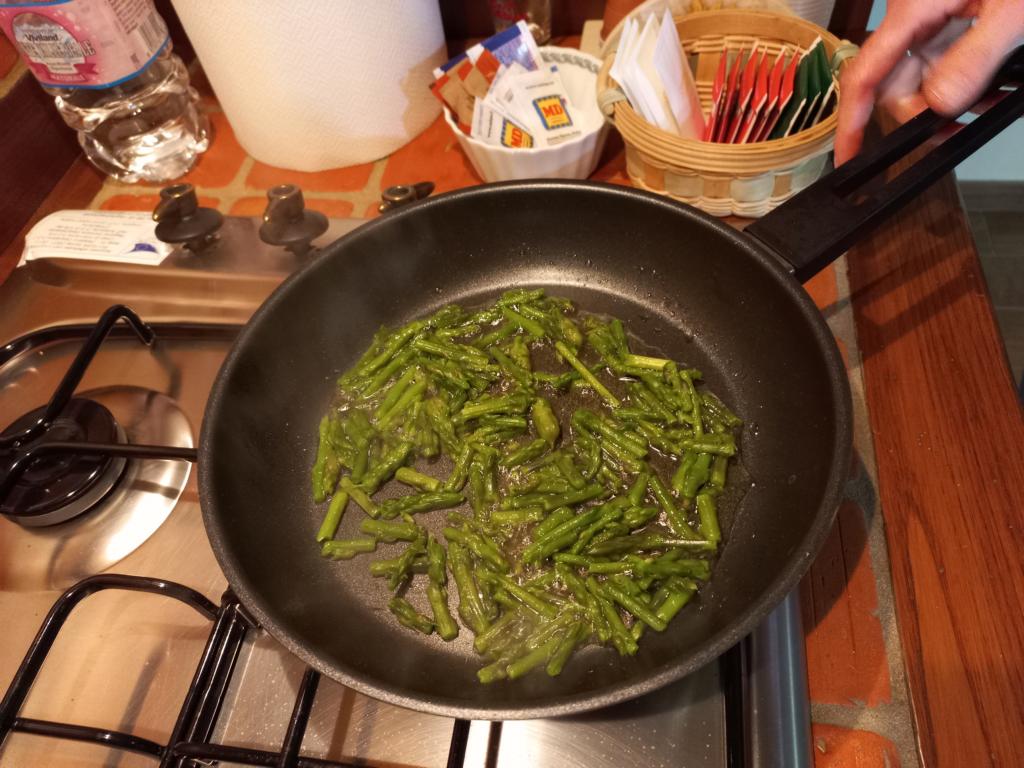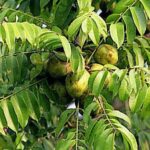Wild asparagus, a unique culinary delight, is prominent in Sicily’s springtime cuisine. The region boasts two distinct species: Asparagus albus, White asparagus, and Asparagus acutifolius, affectionately dubbed ‘Wild asparagus’ in English. Another edible part of these plants is its ‘crown’ of roots, which is seldom eaten. Therefore, we will concentrate this article on the young spears of these two asparagus species.

Distribution and description
Asparagus acutifolius
This species is distributed throughout the arid and rocky areas of the Mediterranean region. It typically occurs in maquis/macchia and garrigue shrubland biomes and avoids sandy areas, like parts of the northern coast of Africa. They prefer shaded locations, like behind rocks, under shrubs, or trees. Young spears, tender enough for eating, appear from the beginning of February until the middle of March.

This species’ appearance is bushy, with spiny and short cladodes (‘leaves’ for photosynthesis). Its plant volume is about double that of A. albus. Spear branching starts at an early stage.


Asparagus albus
Its distribution area is considerably smaller than that of A. acutifolius, and it is restricted to the western part of the Mediterranean region.

It is easy to recognize White asparagus due to its glossy-white stems. The plant volume is significantly smaller, and the cladodes are considerably longer than A. acutifolius cladodes are. A. albus appears more like a small tree than a bush in free-standing locations. The time for collecting edible spears is the same as at A. acutifolius.


Wild asparagus for food
Tasting raw spears
We collected young spears of both asparagus species in the wild during our trip to Sicily at the beginning of March 2024. Both species initially had the same degree of slight bitterness when tasting them raw. Although they looked different, they tasted the same. After the initial bitter taste, a distinctive sweetness developed in the mouth, which lingered for about half an hour and left a delightful and lasting impression.
Buying wild-grown asparagus spears

We did not want to collect too many spears in the wild and compete with locals, so we bought a bunch of Asparagus albus spears from a street vendor. This friendly old man supplemented his pension by collecting wild asparagus in the morning and selling them in the afternoon beside the road.

To our surprise, a greengrocer in Cefalù sold cultivated vegetables, wild asparagus spears, and young shoots of Butcher’s broom (Ruscus hypoglossum) collected by one of his relatives in the mountains.
Preparing asparagus spears Sicily-style
Italians love to cook, eat together, and socialize. They were the creators of slow food cooked to the point. Although Sicilians do not always feel like Italians, they esteem themselves more as descendants of Greek gods and Phoenicians and share the same love for food as most Italians do. So, when we went to our B&B and told the owner we wanted to prepare a ‘Frittata di asparagi’ with the collection of the day ourselves, she was outright disappointed. How could a foreigner prepare a dish representing Sicily’s heart and soul?
Sensing her disapproval, we asked her to help prepare it with us. This was a good start for her. From that moment onwards, she took over the cooking completely, and I am left to comment on the various cooking steps below.
Stages of preparing a ‘Frittata di asparagi’
- Break off about 3 cm long pieces of the spears until there is no longer a clean break. The remaining parts are too stringy to eat and will be disposed of.


- Washing of the remaining asparagus tips.

- The tips will be cooked in salt water and boiled until tender. This step will also remove the bitterness.


- For the number of asparagus tips we had, two eggs were vigorously beaten until foamy.


- The boiled tips of asparagus will be roasted in hot oil.

- The foamy beaten egg will be added. And – oh god, we did not have it – a good portion of Pecorino Romano cheese is essential.

- The frittata will be browned on both sides until the egg mixture is set.

- Finally, the essential part of the exercise follows: Ladling up the plate and eating the frittata on a chunk of this heavenly-tasting Sicilian slice of bread.


This is a truly simple recipe, but it tastes great. Many more ingredients can be added, but simplicity brings out the best in the basic ingredient—wild asparagus.
Another simple recipe is to fry the spear tips in olive oil, sprinkle lemon juice, and eat them with bread.
Lessons learned from wild asparagus in Sicily:
- There are two different species of wild asparagus in Sicily.
- Both species look different from the outside, but their spears taste the same.
- Never offend a Sicilian homemaker by wanting to cook yourself.
- ‘Frittata di asparagi’ on local bread is one of the best foods of Sicily (at least for my taste)
.





